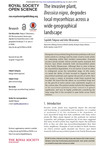Please use this identifier to cite or link to this item:
http://lib.hpu.edu.vn/handle/123456789/23684Full metadata record
| DC Field | Value | Language |
|---|---|---|
| dc.contributor.author | Pakpour, Sepideh | en_US |
| dc.contributor.author | Klironomos, John | en_US |
| dc.date.accessioned | 2016-10-11T05:37:52Z | |
| dc.date.available | 2016-10-11T05:37:52Z | |
| dc.date.issued | 2015 | en_US |
| dc.identifier.other | HPU4160601 | en_US |
| dc.identifier.uri | https://lib.hpu.edu.vn/handle/123456789/23684 | - |
| dc.description.abstract | Disruption of mycorrhizal fungi that form symbioses with local native plants is a strategy used by some invasive exotic plants for competing within their resident communities. Example invasive plants include Alliaria petiolata(garlic mustard) and Brassica nigra(black mustard), both non-mycorrhizal plants in the Family Brassicaceae. Although there is clear evidence for mycorrhizal degradation, it is not known if such an effect is widespread across the naturalized range. | en_US |
| dc.format.extent | 4 p. | en_US |
| dc.format.mimetype | application/pdf | - |
| dc.language.iso | en | en_US |
| dc.subject | Biology | en_US |
| dc.subject | Plant science | en_US |
| dc.subject | Ecology | en_US |
| dc.subject | Brassica nigra | en_US |
| dc.subject | Mycorrhizal fungi | en_US |
| dc.subject | Symbiosis | en_US |
| dc.title | The invasive plant, Brassica nigra,degrades local mycorrhizas across a wide geographical landscape | en_US |
| dc.type | Article | en_US |
| dc.size | 321KB | en_US |
| dc.department | Education | en_US |
| Appears in Collections: | Education | |
Files in This Item:
| File | Description | Size | Format | |
|---|---|---|---|---|
| 0484_Theinvasiveplant.pdf Restricted Access | 321.09 kB | Adobe PDF |  View/Open Request a copy |
Items in DSpace are protected by copyright, with all rights reserved, unless otherwise indicated.
